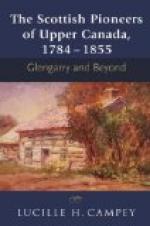Sir Francis Drake led the way in the exploration of the north-west coast of North America. He reached, in 1579, as far north on that side as the country of Oregon, which he christened New Albion. This action stirred up the Spaniards, who explored the coast of California, and in 1591-2 sent an Ionian Island pilot, Apostolos Valeriano (commonly called Juan de Fuca), in charge of an expedition to discover the imagined Straits of Anian. He gave strength to this idea of a continuous water route across temperate North America by entering (in 1592) the straits, since called Juan de Fuca, between Vancouver Island and the modern State of Washington, and passing thence into the Straits of Georgia, which bear a striking resemblance in their features to the Straits of Magellan.
French explorers and adventurers, as we have seen, penetrated from the basin of the St. Lawrence to the north and west until they touched the southern extension of Hudson Bay (James’s Bay), discovered Lake Winnipeg and the Saskatchewan Rivers, the upper Missouri and the whole course of the Mississippi, and finally recorded the existence of the Rocky Mountains.
Parallel with these movements the British discovered the broad belt of sea between Greenland and North America and the whole area of Hudson Bay. After the French had ceased to reign in North America, the British were to reveal the great rivers flowing into the Arctic Ocean, the coasts and islands of the Arctic Ocean, the Yukon River, and the coasts and islands of British Columbia and Alaska.
The first Europeans, however, to reach Alaska were Russians led by Vitus Bering, a great Danish sea captain in the Russian service. Bering was born in 1680 at Horsens, in the province of Aarhuus, E. Denmark, and entered the service of Peter the Great, who was desirous of knowing where Asia terminated and America began. Bering discovered the straits which bear his name in 1728, and in 1741 was wrecked and died on Bering’s Island. Captain James Cook, the British discoverer of Australia and of so many Pacific islands, completed the work of Bering in 1788 in charting the north-west American coast right into the Arctic Ocean.
It has already been related in Chapter III how the Hudson’s Bay Chartered Company came to be founded. Soon after their first pioneers were established, in 1670, at Fort Nelson, on the west coast of Hudson Bay, near where York Factory now stands, there was born—or brought out from England as an infant—a little boy named Henry Kellsey, who as a child took a great fancy to the Amerindians who came to trade at Fort Nelson. As he played with them, and they returned his affection, he learnt their language, and—for some inconceivable reason—this gave great offence to the stupid governor of the fort (indeed, when Kellsey as a grown man, some years afterwards, compiled a vocabulary of the Kri language for the use of traders, the Hudson’s Bay Company ordered it to be suppressed). Stupid Governor Geyer not only objected to Kellsey picking up the Kri language, but punished him most severely for that and for his boyish tricks and jokes; so much so, that Kellsey, when he was about ten years old, ran away with the returning Indians, some of whom had grown very fond of him whilst they stayed at Fort Nelson.




